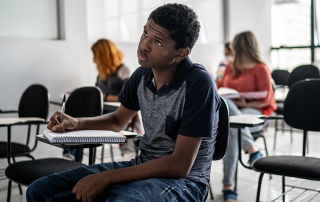CAPR Publications
Long-Term Effects of the Dana Center Math Pathways Model: Evidence From a Randomized Trial
Susan Sepanik and Sukanya Barman | October 2023
This working paper reports on longer term impacts on students’ math completion, academic progress, and academic attainment from a randomized controlled trial of an early model of Dana Center Math Pathways (DCMP).
Lessons from the Dana Center’s Corequisite Research Design Collaborative Study
By Oscar Cerna, Vivianna Plancarte, Julia Raufman, Jorge Mahecha-Rodriguez, and Ellen Wasserman | September 2023
This research brief and supplement highlight findings on the design and implementation of corequisite courses at four colleges, as well as findings from a survey administered to students who were enrolled in these courses in fall 2021 and spring 2022.
Five Principles for Reforming Developmental Education: A Review of the Evidence
Susan Bickerstaff, Katie Beal, Julia Raufman, Erika B. Lewy, and Austin Slaughter | October 2022
In a review of impact and implementation studies from the past ten years, this CAPR report summarizes what is known about how innovations to developmental education can improve student outcomes, and it draws out five principles that are key for reform.
The Next Phase of Placement Reform: Moving Toward Equity-Centered Practice
By Elizabeth Kopko, Jessica Brathwaite, and Julia Raufman | August 2022
This brief provides guidance to institutions seeking to design and implement placement systems that redress limitations of test-only systems and that work in conjunction with other reforms to generate more equitable outcomes.
Reviewing the Research on Informed Self-Placement: Practices, Justifications, Outcomes, and Limitations
By Tiffany Morton | June 2022
This brief reviews the existing research on informed self-placement (ISP). It discusses the processes and methods used to implement ISP as well as justifications for its use, provides an overview of the available data about how students behave and perform when ISP is used, and makes recommendations for future study.
Informed Self-Placement Today: An Exploratory Study of Student Outcomes and Placement Practices
By Jessica Brathwaite, Dan Cullinan, Elizabeth Kopko, Tiffany Morton, Julia Raufman, and Dorota Rizik | June 2022
This brief presents the findings of CAPR’s exploratory study of informed self-placement (ISP), a placement system in which colleges provide information about placement policies, available courses, and other relevant topics to engage students as active participants in their own placement.
Interim Findings from the Dana Center Mathematics Pathways Long-Term Follow-Up Study
By Dorota Biedzio and Susan Sepanik | March 2022
This brief presents interim findings for the first three years after random assignment and provides an exploratory analysis of the effectiveness of the Dana Center Mathematics Pathways (DCMP) program for various subgroups.
Lessons From Two Experimental Studies of Multiple Measures Assessment
Dan Cullinan and Elizabeth Kopko | January 2022
This brief describes findings from two experimental studies of multiple measures assessment, in which colleges use measures beyond placement test scores to determine students’ college readiness.
Implementing and Scaling Multiple Measures Assessment in the Context of COVID-19
Susan Bickerstaff, Elizabeth Kopko, Erika B. Lewy, Julia Raufman, and Elizabeth Zachry Rutschow | January 2021
Based on interviews with system leaders and college administrators, faculty, and staff, this brief presents four short case studies on how community college state systems changed placement policies and supported new placement practices in the midst of the pandemic.
Who Should Take College-Level Courses? Impact Findings From an Evaluation of a Multiple Measures Assessment Strategy
By Elisabeth A. Barnett, Elizabeth Kopko, Dan Cullinan, and Clive R. Belfield | October 2020
This report describes impact findings from an evaluation of multiple measures assessment and placement at seven State University of New York (SUNY) community colleges.










